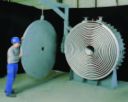The heat exchanger is a device which is needed to transfer thermal energy (heat) between two liquids with different temperatures
There are many types of heat exchangers which vary depending on the different type of liquid used to transmit and exchange heat.
Heat exchangers are “passive” devices that do not generate heat. They simply transfer it.
There are mixing and surface heat exchangers: quite a few of the latter type are on the market and are classified depending on the building type.
The different heat exchanger types, based on construction technology, are:
- (shell and tube) heat exchanger: one of the liquids goes through the circular section tubes and the other one circulates on the outside of these same tubes which have deflectors (septa) that increase their turbulence (i.e. the heat exchange);
- (plate heat exchangers): the two liquids lap the opposite sides of flat or corrugated stainless steel by inserting turbulators in alternating areas. They are isolated from each other by seals and and weldings (inspected or welded), usually in counterflow motion;
- spiral heat exchangers: the two fluids pass on the opposite sides of a smooth plate wound in a spiral casing;
- heat exchanger blocks: the liquids circulate in cylindrical (or oval) holes, usually placed at right angles on the two sides (typical construction in graphite);
- finned, battery or radiator heat exchangers: one of the fluids goes through the inside of the tubes and the other (gas-type) goes through the finned pack on the outside of the tubes.

